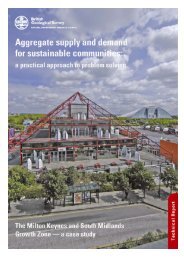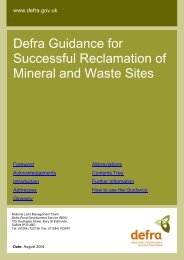creating environmental improvements through biodiversity
creating environmental improvements through biodiversity
creating environmental improvements through biodiversity
You also want an ePaper? Increase the reach of your titles
YUMPU automatically turns print PDFs into web optimized ePapers that Google loves.
extended to work more with quarry operators, including a promotional event in late 2005 – early 2006.<br />
It was suggested that radio tracking of GHBs be carried out specifically around quarries to get up to date<br />
information on foraging and roosting sites, and an event for bat and dormice fieldworkers was to be arranged<br />
in spring 2006.<br />
Dissemination:<br />
The project consisted largely of disseminating information on the target species, good habitat management<br />
practices and available grant schemes.<br />
It disseminated results of a previous local study on habitat use by GHBs.<br />
There was press coverage of project community events, but not of the report’s release.<br />
The report was distributed to funders: MIRO/MIST, Somerset County Council SALSF (also connected<br />
with Quarry Producers Forum), Mendip District Council, English Nature, Somerset Wildlife Trust’s Bat and<br />
Mammal Groups, Mendip AONB Team and possibly BNES Council.<br />
DEVELOPING POLICY AND BEST PRACTICE IN RELATION TO<br />
RESTORATION FOLLOWING MINERALS EXTRACTION – RESOLVING<br />
CONFLICTS WITH AVIATION (MIRO, ODPM, DCLG - CSL, RSPB)<br />
Literature Review Richard Walls (Central Science Laboratory)<br />
March 2004<br />
Sustainable Aggregates Creating Environmental Improvements <strong>through</strong> Biodiversity<br />
Project Type: Literature review<br />
Site: Various case studies<br />
Project Aim:<br />
To identify types of minerals restorations leading to the presence of hazardous bird species<br />
To help identify suitable restoration strategies for sites close to airports for both <strong>biodiversity</strong> conservation<br />
and flight safety<br />
To develop policy and best practice in relation to the restoration of sites following minerals extraction and<br />
resolve possible conflicts with aviation during the ‘safeguarding process’<br />
Main Methods:<br />
Review of published information and ‘grey’ literature on minerals extraction restorations and wildlife, using<br />
Biosis Previews 2003, Web of Science, Google and the Dialog host, and by contacting county council planning<br />
offices<br />
Evaluation of current state of knowledge<br />
GIS analysis of wetland characteristics, bird populations and bird movement data (bird movements detected<br />
by radar in the Cotswold Water Complex)<br />
Output:<br />
Points out that there is currently no comprehensive / standardised monitoring of mineral site restorations<br />
across the UK – information currently held at county council level and by interested conservation bodies and<br />
individual minerals operators<br />
Points out that scientific literature contains papers on waterfowl populations and wetland habitat use but few<br />
specifically for minerals sites<br />
Points out that county council records alone hold a highly variable amount of relevant information in many<br />
forms (paper and electronic)<br />
Points to best practice guides produced by the RSPB, Wildfowl and Wetlands Trust (WWT) and Game<br />
Conservancy Council (GCC)<br />
89

















